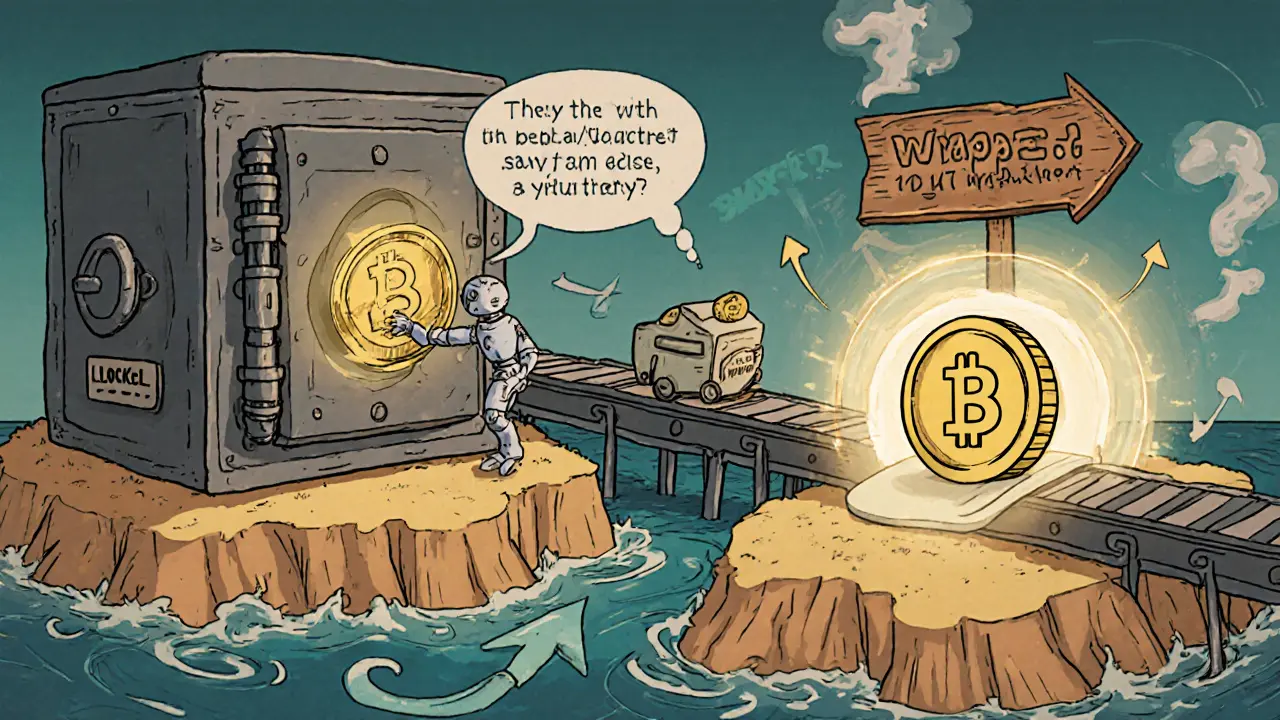Cross-Chain Bridge Comparison Tool
This tool compares major cross-chain bridge characteristics to help you choose the right one for your needs.
Trusted Bridges
Controlled by a single entity or consortium. Usually faster but require trust in the operator.
Fast Centralized CustodialTrustless Bridges
Managed by decentralized validators or smart contracts. More secure but potentially slower.
Secure Decentralized Non-custodialBridge Features Comparison
| Feature | Trusted Bridge | Trustless Bridge |
|---|---|---|
| Governance | Single entity or consortium | Decentralized validators |
| Security Model | Depends on operator security | On-chain code and consensus |
| Speed | Usually fast (batched) | Potentially slower (confirmations) |
| Examples | Binance Bridge, Crypto.com Bridge | Wormhole, Polkadot, Cosmos IBC |
Popular Bridge Projects
Wormhole
Connects Ethereum, Solana, BNB Chain, and Terra. Known for low fees and fast finality.
TrustlessPolkadot
Uses relay chain to enable parachains to communicate. Focuses on shared security.
TrustlessCosmos
Uses IBC protocol for asset and data exchange. Called the "Internet of Blockchains".
TrustlessAtomic Swaps
Peer-to-peer token exchanges using HTLCs. No bridge contracts needed.
TrustlessUse Case Scenarios
DeFi Yield Farming
Move USDC from Ethereum to Avalanche for higher yields.
NFT Portability
Transfer NFT from Solana to Ethereum marketplace.
Cross-Chain Payments
Convert Bitcoin to WBTC for Ethereum-based platforms.
Safety Tips
- Prefer trustless bridges with third-party audits
- Check bridge history for security incidents
- Start with small amounts to test functionality
- Verify wrapped token contracts on block explorers
- Monitor network fees for cost-effectiveness
When you hear the term cross‑chain bridges are protocols that connect separate blockchain networks, allowing assets and data to move between them, you might wonder why they matter. In a world where Bitcoin lives on its own chain, Ethereum runs a completely different system, and newer networks like Solana sprint ahead with their own rules, bridges act like the highways that let traffic flow without stopping at every border.
Why Bridges Are Needed
Imagine owning a rare NFT on Ethereum but wanting to sell it on a marketplace that only runs on Solana because the fees are lower. Without a bridge, you’d have to list the NFT, wait for a buyer, cash out to a centralized exchange, then buy Solana tokens to re‑mint the NFT on the other chain - a process that costs time, money, and trust in a middleman. Bridges eliminate that friction by letting the same asset exist on multiple chains at the same time.
How the Lock‑and‑Mint Model Works
The most common design is lock‑and‑mint. Here’s a step‑by‑step rundown:
- A user sends the original token to a smart contract on the source chain.
- The contract locks (or burns) the token, guaranteeing it can’t be spent there again.
- On the destination chain, a corresponding “wrapped” token is minted, maintaining a 1:1 peg.
- When the user wants the original back, the wrapped token is burned and the source contract releases the locked amount.
This pattern keeps total supply constant and prevents double‑spending. A real‑world example is Wrapped Bitcoin (WBTC) a token on Ethereum that represents Bitcoin at a 1:1 ratio. By holding WBTC, Ethereum users can put Bitcoin into DeFi protocols that only understand ERC‑20 tokens.

Trusted vs. Trustless Bridges
Not all bridges are created equal. Broadly, they fall into two camps: trusted (centralized) and trustless (decentralized). The table below highlights the key differences.
| Aspect | Trusted Bridge | Trustless Bridge |
|---|---|---|
| Governance | Controlled by a single entity or consortium | Managed by a decentralized set of validators or smart contracts |
| Security Model | Relies on the custodian’s security practices | Relies on on‑chain code and consensus mechanisms |
| Speed | Usually fast, as the custodian can batch transactions | Potentially slower due to multiple validator confirmations |
| Examples | Binance Bridge, Crypto.com Bridge | Wormhole a trustless bridge linking Ethereum, Solana, and other chains, Polkadot offers cross‑chain messaging via its relay chain |
Major Bridge Projects and Their Ecosystems
Several projects have become go‑to solutions for developers and traders:
- Wormhole connects Ethereum, Solana, BNB Chain, and Terra - known for low fees and fast finality.
- Polkadot provides a relay chain that enables parachains to talk to each other - focuses on shared security.
- Cosmos uses the Inter‑Blockchain Communication (IBC) protocol for asset and data exchange - called the "Internet of Blockchains".
- Atomic Swaps allow peer‑to‑peer token exchanges without a bridge contract, using hash time‑locked contracts (HTLCs) - ideal for trustless, direct trades.
Practical Use Cases
Here are three everyday scenarios where bridges shine:
- DeFi Yield Farming Across Chains: A user holds USDC on Ethereum but wants higher yields on Avalanche. By sending USDC through a bridge, the token becomes USDC‑A on Avalanche, where it can be supplied to a high‑APY lending pool.
- NFT Portability: An artist mints an artwork on Solana a high‑throughput blockchain popular for NFTs. To list it on an Ethereum marketplace, the artist bridges the NFT, receiving an ERC‑721 wrapper that mirrors the original metadata.
- Cross‑Chain Payments: A freelancer gets paid in Bitcoin but wants to spend the funds on an Ethereum‑based platform. A bridge locks the Bitcoin on its native chain and mints an equivalent amount of WBTC on Ethereum, instantly usable for subscriptions, gaming, or DeFi.

Safety Tips and Common Pitfalls
Bridges are powerful, but they’re also prime targets for attackers. Here’s a quick checklist:
- Prefer trustless bridges that have undergone third‑party audits.
- Check the bridge’s history - any major hacks? (e.g., the 2022 Wormhole exploit caused a $320M loss.)
- Start with a small amount to confirm the process works as expected.
- Watch for “wrapped” token contracts that haven’t been verified on block explorers.
- Keep an eye on network fees; sometimes the cost of bridging outweighs the benefit.
Future Directions for Interoperability
The industry is moving toward unified standards. Projects like LayerZero offers an omnichain messaging layer that could replace many point‑to‑point bridges aim to reduce friction even further. Meanwhile, Ethereum’s upcoming rollups and Polkadot’s parachain upgrades promise native cross‑chain calls without needing separate bridge contracts.
As blockchain ecosystems grow, the ability to move assets, data, and commands seamlessly will be as essential as the internet’s protocols that let browsers talk to servers. Cross‑chain bridges are the first, and increasingly sophisticated, building blocks of that inter‑connected future.
Frequently Asked Questions
What exactly is a cross‑chain bridge?
A cross‑chain bridge is a protocol that links two separate blockchain networks, allowing tokens, NFTs, or data to move between them by locking the original asset on one chain and minting a wrapped version on the other.
How does the lock‑and‑mint process keep the supply balanced?
When the source contract locks (or burns) the original token, it becomes unavailable on that chain. The bridge then mints a new token on the destination chain that represents the same amount. Burning the wrapped token releases the locked original, preserving a 1:1 total supply.
Are trustless bridges completely risk‑free?
No. While they remove a central custodian, they still depend on the correctness of smart‑contract code. Bugs or exploitable logic can lead to losses, as seen in past Wormhole and Bungee Bridge incidents.
What is the difference between a bridge and an atomic swap?
A bridge usually involves a custodial or contract‑based lock‑and‑mint flow, while an atomic swap directly exchanges two tokens across chains using hash‑time‑locked contracts, without creating wrapped assets.
Which bridge should I use for moving USDC from Ethereum to Polygon?
The Polygon PoS Bridge is a widely used, trustless option that locks USDC on Ethereum and mints Polygon‑USDC. It’s fast, cheap, and has been audited by reputable firms.

